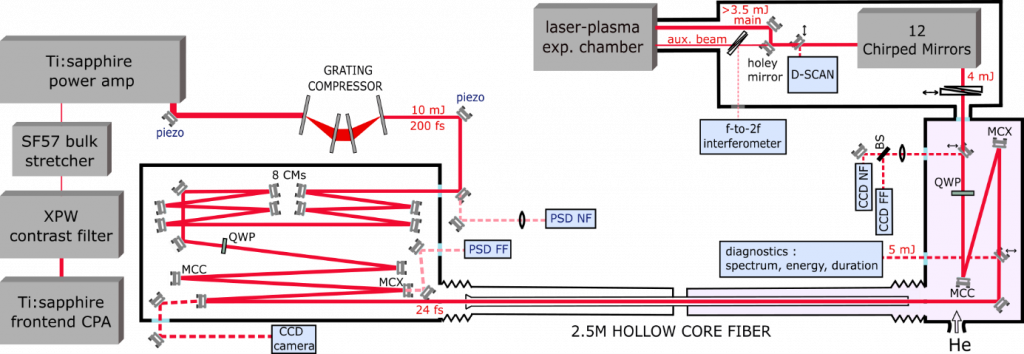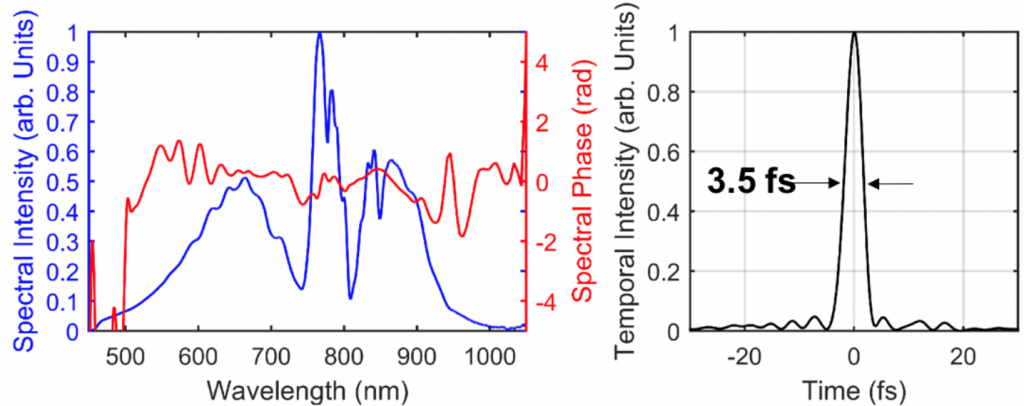Laser development : ultra-short and ultra-intense

The laser used to attain ultra-high, so-called relativistic intensities are almost always lasers amplified to very high pulse energies on the order Joules. This energy level constrains them to function at rather low repetition rates of typically a few Hz, so as to leave cool-down time between successive laser shots. Moreover, these amplifiers limit the attainable pulse durations to no less than a few tens of femtoseconds. One might call this the brute-force approach: while it allows generating very high optical intensities, this architechture remains limited in terms of temporal resolution, spatial beam quality, shot-to shot stability and simply productivity (on the order of only 1 shot per second).
The laser developed by the PCO group, which is the heart of the “Salle Noire” laboratory at LOA, takes a different approach. It only produces a few millijoules per pulse, which allows it to function at a much high repetition rate of 1 kHz, but also to seed a so-called post-compression stage which gives access to much shorter pulse durations of a few femtoseconds only.
After a double-CPA amplifier chain including an XPW filter stage for temporal contrast cleaning, the post-compression is based on a long stretched hollow-core fiber filled with helium. The nonlinear interaction of the laser pulses with that gas produces 3.5-fs pulses of 3.5 mJ energy, with a remarkable spatial beam quality thanks to the beam guiding in the fiber. Therefore, the modest pulse energy of this laser is compensated by a much shorter pulse duration, which combines to a peak power of 1 terawatt (1012 W). The Salle Noire of LOA houses the only laser worldwide offering this kind of power in pulses less than 2 cycles long. Its excellent spatial quality then allows focusing its beam to very small dimensions to concentrate that power in space. In the focal spot of about 2 μm diameter, the intensity reaches a value of 1 TW/(π.1 μm)2 ~1019 W/cm2 !


In the PCO group of LOA we continuously develop this laser to improve is robustness and stability. This includes the deployment of soatio-temporal disgnostic tools so as as to finely characterize the on-target intensity distribution and better control the interaction conditions. We develop all these technological building blocks in parallel in a second laboratory and integrate them into the productive laser chain at Salle Noire once they have proven themselves.
Associated publications :
- Jaismeen Kaur et al., J. Phys. Photonics 6, 015001 (2023).
- « Relativistic-intensity near-single-cycle light waveforms at kHz repetition rate», Marie Ouillé, Aline Vernier, Frederik Böhle, Maïmouna Bocoum, Aurélie Jullien, Magali Lozano, Jean-Philippe Rousseau, Zhao Cheng, Dominykas Gustas, Andreas Blumenstein, Peter Simon, Stefan Haessler, Jérôme Faure, Tamas Nagy and Rodrigo Lopez-Martens, Light: Science & Applications 9, 1-9 (2020)
- « Generation of few-cycle laser pulses with high temporal contrast via nonlinear elliptical polarisation rotation in a hollow fibre compressor», NG Khodakovskiy, MP Kalashnikov, V Pajer, A Blumenstein, P Simon, MM Toktamis, M Lozano, B Mercier, Z Cheng, T Nagy, and R Lopez-Martens, Laser Physics Letters 16, 095001 (2019)
- « Passive coherent combining of CEP-stable few-cycle pulses from a temporally divided hollow fiber compressor», Hermance Jacqmin, Aurélie Jullien, Brigitte Mercier, Marc Hanna, Frédéric Druon, Dimitrios Papadopoulos and Rodrigo Lopez-Martens, Optics Letters 40, 709-712 (2015)
- « Carrier-envelope-phase stable, high-contrast, double chirped-pulse-amplification laser system» Aurélie Jullien, Aurélien Ricci, Frederik Böhle, Jean-Philippe Rousseau, Stéphanie Grabielle, Nicolas Forget, Hermance Jacqmin, Brigitte Mercier and Rodrigo Lopez-Martens, Optics Letters 39, 3774-3777 (2014)
- « Compression of CEP-stable multi-mJ laser pulses down to 4 fs in long hollow fibers», Frederik Böhle, Martin Kretschmar, Aurélie Jullien, Mate Kovacs, Miguel Miranda, Rosa Romero, Helder Crespo, Uwe Morgner, Peter Simon, Rodrigo Lopez-Martens and Tamas Nagy, Laser Physics Letters 11, 095401 (2014)
- « Energy-scalable temporal cleaning device for femtosecond laser pulses based on cross-polarized wave generation» Aurélien Ricci, Aurélie Jullien, Jean-Philippe Rousseau, Yi Liu, Aurélien Houard, Patricia Ramirez, Dimitris Papadopoulos, Alain Pellegrina, Patrick Georges, Frédéric Druon, Nicolas Forget and Rodrigo Lopez-Martens, Review of Scientific Instruments 84, 043106 (2013)


